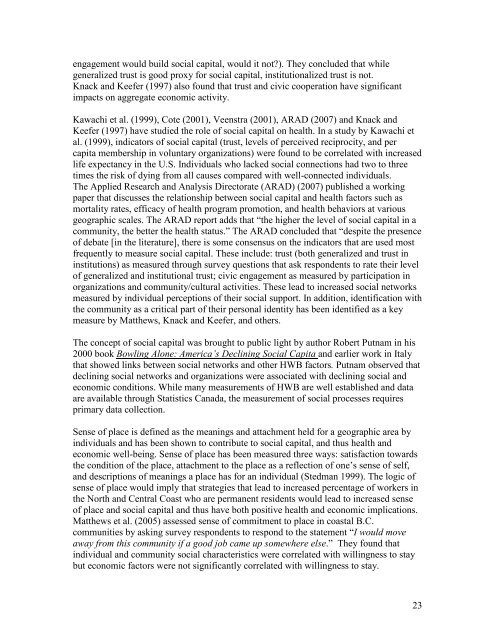Final report - Integrated Land Management Bureau
Final report - Integrated Land Management Bureau
Final report - Integrated Land Management Bureau
Create successful ePaper yourself
Turn your PDF publications into a flip-book with our unique Google optimized e-Paper software.
engagement would build social capital, would it not?). They concluded that while<br />
generalized trust is good proxy for social capital, institutionalized trust is not.<br />
Knack and Keefer (1997) also found that trust and civic cooperation have significant<br />
impacts on aggregate economic activity.<br />
Kawachi et al. (1999), Cote (2001), Veenstra (2001), ARAD (2007) and Knack and<br />
Keefer (1997) have studied the role of social capital on health. In a study by Kawachi et<br />
al. (1999), indicators of social capital (trust, levels of perceived reciprocity, and per<br />
capita membership in voluntary organizations) were found to be correlated with increased<br />
life expectancy in the U.S. Individuals who lacked social connections had two to three<br />
times the risk of dying from all causes compared with well-connected individuals.<br />
The Applied Research and Analysis Directorate (ARAD) (2007) published a working<br />
paper that discusses the relationship between social capital and health factors such as<br />
mortality rates, efficacy of health program promotion, and health behaviors at various<br />
geographic scales. The ARAD <strong>report</strong> adds that “the higher the level of social capital in a<br />
community, the better the health status.” The ARAD concluded that “despite the presence<br />
of debate [in the literature], there is some consensus on the indicators that are used most<br />
frequently to measure social capital. These include: trust (both generalized and trust in<br />
institutions) as measured through survey questions that ask respondents to rate their level<br />
of generalized and institutional trust; civic engagement as measured by participation in<br />
organizations and community/cultural activities. These lead to increased social networks<br />
measured by individual perceptions of their social support. In addition, identification with<br />
the community as a critical part of their personal identity has been identified as a key<br />
measure by Matthews, Knack and Keefer, and others.<br />
The concept of social capital was brought to public light by author Robert Putnam in his<br />
2000 book Bowling Alone: America’s Declining Social Capita and earlier work in Italy<br />
that showed links between social networks and other HWB factors. Putnam observed that<br />
declining social networks and organizations were associated with declining social and<br />
economic conditions. While many measurements of HWB are well established and data<br />
are available through Statistics Canada, the measurement of social processes requires<br />
primary data collection.<br />
Sense of place is defined as the meanings and attachment held for a geographic area by<br />
individuals and has been shown to contribute to social capital, and thus health and<br />
economic well-being. Sense of place has been measured three ways: satisfaction towards<br />
the condition of the place, attachment to the place as a reflection of one’s sense of self,<br />
and descriptions of meanings a place has for an individual (Stedman 1999). The logic of<br />
sense of place would imply that strategies that lead to increased percentage of workers in<br />
the North and Central Coast who are permanent residents would lead to increased sense<br />
of place and social capital and thus have both positive health and economic implications.<br />
Matthews et al. (2005) assessed sense of commitment to place in coastal B.C.<br />
communities by asking survey respondents to respond to the statement “I would move<br />
away from this community if a good job came up somewhere else.” They found that<br />
individual and community social characteristics were correlated with willingness to stay<br />
but economic factors were not significantly correlated with willingness to stay.<br />
23
















